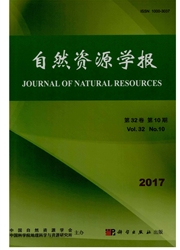

 中文摘要:
中文摘要:
通过对北京市蔬菜和菜地土壤镍含量状况进行大规模调查,研究蔬菜和土壤镍含量及其健康风险,并筛选出抗镍污染能力强的蔬菜品种。根据蔬菜的消费量同时兼顾品种多样性的原则,在北京市规模化蔬菜栽培基地(采集蔬菜及土壤样品)和蔬菜批发市场(蔬菜样品)共采集97种蔬菜412个样品和54个土壤样品。研究发现:北京市菜地土壤镍含量呈正态分布,其含量范围、算术均值和中值分别为2.8-46.5、25.89和25.75mg/kg。均远低于《土壤环境质量标准》中的农业土壤标准(pH〉7.5时,250mg/kg);北京市蔬菜镍含量范围、算术均值、几何均值和Box-Cox均值分别为0.7~1689.0、91.3、53.0和55.41μg/kg;瓜果类蔬菜的镍平均含量显著高于叶菜类,其它类型差异不显著;北京市本地产蔬菜与市售外地产蔬菜的镍含量没有显著差异;裸露地蔬菜镍含量显著高于设施栽培蔬菜;云架豆镍富集系数较高,黄瓜、小白菜、萝卜,甘蓝、辣椒、大白菜和冬瓜次之,而大葱、叶甜菜、茄子、西红柿和部分特菜等镍富集系数最低。北京市居民从蔬菜中摄人镍的量为99.5μg/(人·d),蔬菜镍对北京市部分人群存在一定的健康风险。
 英文摘要:
英文摘要:
In order to assess healthy risk of nickel in vegetables and to with high pollutant-resistance,a large scale survey on nickel concentrations select vegetable variety in vegetable lands and vegetables planted or sold in Beijing,were carried out.A total of 54 soil samples were collected from vegetable lands and their nickel concentrations were determined using Graphite Furnace Atomic Absorption Spectrometry (GF-AAS).In addition,97 varieties with 412 fresh samples of vegetables were obtained from vegetable bases,supermarkets and wholesale markets,with sampling principle of taking both consumption and diversity of vegetables into account.The results showed that the nickel concentrations in vegetable lands ranged from 2.8 to 46.5mg·kg^-1,with median, arithmetical means (AM)and arithmetical standard deviation (SD)of 25.75,25.89 and 7.33mg ·kg^-1, respectively.Compared with the background concentrations of soil nickel in Beijing, nickel was found to be accumulated not significantly in the vegetable lands.Nickel concentrations in the vegetables ranged from 0.7 to 1689.01μg ·kg^-1 fresh weight,with arithmetical and geometrical and Box-Cox means of 91.3μg· kg^-1,53.0μg· kg^-1 and 55.4μg· kg^-1fresh weight,respectively.Nickel in most of the samples (97.38%)was below the limit, 3.0mgμg· kg^-1 and 0.3mgμg· kg^-1 fresh weight pulse vegetables and other vegetables,respectively,set by Tolerance Limit of Nickel in Foods for the maximum permissible concentration of nickel in vegetables.The highest nickel concentration, 1689.0μg· kg^-1,was found in a green soybean(maodou)sample,followed by a cowpea (Vigna ungiculata)and soybean sprouts sample,992.7 and 965.8μg· kg^-1,respectively,and then pea (Pisum sativum),celery (Apium graveolens)and horse bean (Vicia faba),745.3,704.3 and 697.4μg· kg^-2, respectively.The nickel concentration of vegetables planted in the open field was significantly higher than those planted in greenhouse.Results of hierarchical cluster analysis on bioconcen
 同期刊论文项目
同期刊论文项目
 同项目期刊论文
同项目期刊论文
 期刊信息
期刊信息
